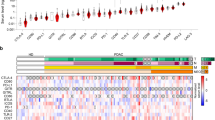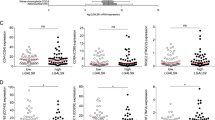Abstract
The aim of this paper was to determine the clinical significance of the MHC class I chain-related molecule A(MICA) and NKG2D receptor on NK cells in pancreatic cancer. We compared MICA expression in malignant (n = 103), inflammatory (n = 28), and normal (n = 17) pancreatic tissues using immunohistochemistry and assessed serum levels of soluble MICA (sMICA) and NKG2D expression on NK cells in patients with pancreatic cancer (n = 103), in patients with chronic pancreatitis (n = 28), and in healthy volunteers (n = 43). Expression of MICA was detected in 89.3% of pancreatic cancer tissues, whereas fewer were expressed in inflammatory and normal pancreatic tissues. The levels of sMICA were frequently elevated in patients with advanced pancreatic cancer. The elevation of sMICA was associated with down-regulated NKG2D expression and impaired activity of NK cells. The successful tumor resection significantly decreased serum levels of sMICA and increased the NKG2D expression; there was an inverse correlation between change in sMICA levels and that in NKG2D expression. MICA expression, preoperative sMICA levels and NKG2D intensity were found to be independent prognostic factors in resected pancreatic cancer. This study supports the clinical significance of release of MICA for the malignant progression of pancreatic cancer. The successful tumor resection for pancreatic cancer may have a beneficial effect on NKG2D-mediated antitumor immunity. Our results also suggest sMICA and NKG2D expression on NK cells may be useful to identify risk patients at time point of diagnosis.






Similar content being viewed by others
References
Jemal A, et al. Cancer statistics 2007. CA Cancer J Clin. 2007;57(1):43–66.
Levi F, Lucchini F, Negri E, La Vecchia C. Pancreatic cancer mortality in Europe: the leveling of an epidemic. Pancreas. 2003;27(2):139–42.
Kim S, Iizuka K, Aguila HL, Weissman IL, Yokoyama WM. In vivo natural killer cell activities revealed by natural killer cell-deficient mice. Proc Natl Acad Sci USA. 2000;97(6):2731–6.
Pross HF, Lotzova E. Role of natural killer cells in cancer. Nat Immunol. 1993;12(4–5):279–92.
Aparicio-Pagés MN, Verspaget HW, Peña AS, Lamers CB. Natural killer cell activity in patients with adenocarcinoma in the upper gastrointestinal tract. J Clin Lab Immunol. 1991;35(1):27–32.
Bauer S, et al. Activation of NK cells and T cells by NKG2D, a receptor for stress -inducible MICA. Science. 1999;285(5428):727–9.
Groh V, et al. Broad tumor-associated expression and recognition by tumor-derived gamma delta T cells of MICA and MICB. Proc Natl Acad Sci USA. 1999;96(12):6879–84.
Vetter CS, et al. Expression of stress-induced MHC class I related chain molecules on human melanoma. J Invest Dermatol. 2002;118(4):600–5.
Jinushi M, et al. Expression and role of MICA and MICB in human hepatocellular carcinomas and their regulation by retinoic acid. Int J Cancer. 2003;104(3):354–61.
Raulet DH. Roles of the NKG2D immunoreceptor and its ligands. Nat Rev Immunol. 2003;3(10):781–90.
Eisele G, et al. TGF-beta and metalloproteinases differentially suppress NKG2D ligand surface expression on malignant glioma cells. Brain. 2006;129(Pt 9):2416–25.
Watson NF, et al. Expression of the stress-related MHC class I chain-related protein MICA is an indicator of good prognosis in colorectal cancer patients. Int J Cancer. 2006;18(6):1445–52.
Salih HR, Rammensee HG, Steinle A. Cutting edge: down-regulation of MICA on human tumors by proteolytic shedding. J Immunol. 2002;169(8):4098–102.
Holdenrieder S, et al. Soluble MICA in malignant diseases. Int J Cancer. 2006;118(3):684–7.
Rebmann V, et al. Soluble MICA as an independent prognostic factor for the overall survival and progression-free survival of multiple myeloma patients. Clin Immunol. 2007;123(1):114–20.
Vetter CS, Lieb W, Brocker E-B, Becker JC. Loss of non-classical MHC molecules MIC-A/B expression during progression of uveal melanoma. Br J Cancer. 2004;91(8):1495–9.
Groh V, Wu J, Yee C, Spies T. Tumour-derived soluble MIC ligands impair expression of NKG2D and T-cell activation. Nature. 2002;419(6908):734–8.
Diefenbach A, Jensen ER, Jamieson AM, Raulet DH. Rae1 and H60 ligands of the NKG2D receptor stimulate tumour immunity. Nature. 2001;413(6852):165–71.
Li K, et al. Clinical significance of the NKG2D ligands, MICA/B and ULBP2 in ovarian cancer: high expression of ULBP2 is an indicator of poor prognosis. Cancer Immunol Immunother. 2009;58(5):641–52.
Ohashi M, et al. Adenovirus-mediated interferon gene transfer induces regional direct cytotoxicity and possible systemic immunity against pancreatic cancer. Br J Cancer. 2005;93(4):441–9.
Boissel N, et al. BCR/ABL oncogene directly controls MHC class I chain-related molecule A expression in chronic myelogenous leukemia. J Immunol. 2006;176(8):5108–16.
Routes JM, et al. Adenovirus serotype 5 E1A sensitizes tumor cells to NKG2D-dependent NK cell lysis and tumor rejection. J Exp Med. 2005;202(11):1477–82.
Gasser S, Orsulic S, Brown EJ, Raulet DH. The DNA damage pathway regulates innate immune system ligands of the NKG2D receptor. Nature. 2005;436(7054):1186–90.
Märten A, von Lilienfeld-Toal M, Büchler MW, Schmidt J. Soluble MIC is elevated in the serum of patients with pancreatic carcinoma diminishing gammadelta T cell cytotoxicity. Int J Cancer. 2006;119(10):2359–65.
Doubrovina ES, et al. Evasion from NK cell immunity by MHC class I chain-related molecules expressing colon adenocarcinoma. J Immunol. 2003;171(12):6891–9.
Wu JD, et al. Prevalent expression of the immunostimulatory MHC class I chain-related molecule is counteracted by shedding in prostate cancer. J Clin Invest. 2004;114(4):560–8.
Author information
Authors and Affiliations
Corresponding author
Rights and permissions
About this article
Cite this article
Duan, X., Deng, L., Chen, X. et al. Clinical significance of the immunostimulatory MHC class I chain-related molecule A and NKG2D receptor on NK cells in pancreatic cancer. Med Oncol 28, 466–474 (2011). https://doi.org/10.1007/s12032-010-9480-9
Received:
Accepted:
Published:
Issue Date:
DOI: https://doi.org/10.1007/s12032-010-9480-9




